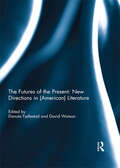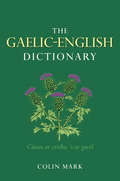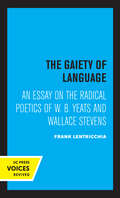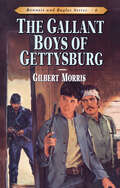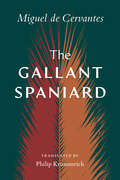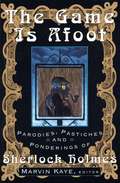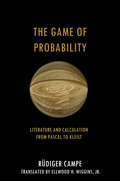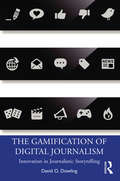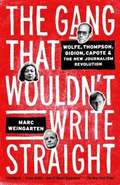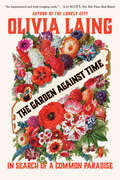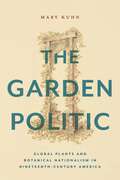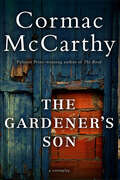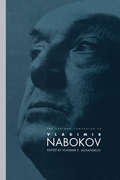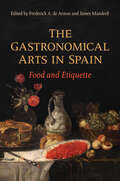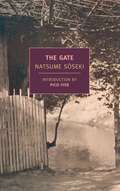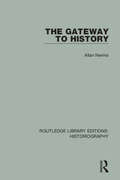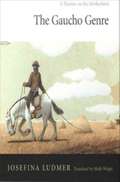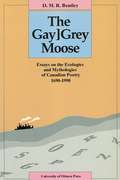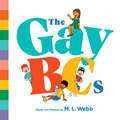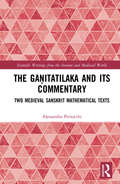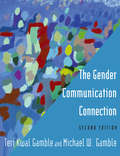- Table View
- List View
The Future of the Soviet Past: The Politics of History in Putin's Russia
by Steven A. Barnes Stephen M. Norris Boris Noordenbos Nikolay Koposov George Soroka Kiril Feferman Johanna Dahlin Štěpán Černoušek Ivan Kurilla Nikita PetrovIn post-Soviet Russia, there is a persistent trend to repress, control, or even co-opt national history. By reshaping memory to suit a politically convenient narrative, Russia has fashioned a good future out of a "bad past." While Putin's regime has acquired nearly complete control over interpretations of the past, The Future of the Soviet Past reveals that Russia's inability to fully rewrite its Soviet history plays an essential part in its current political agenda. Diverse contributors consider the many ways in which public narrative shapes Russian culture—from cinema, television, and music to museums, legislature, and education—as well as how patriotism reflected in these forms of culture implies a casual acceptance of the valorization of Stalin and his role in World War II. The Future of the Soviet Past provides effective and nuanced examples of how Russia has reimagined its Soviet history as well as how that past still influences Russia's policymaking.
The Futures of the Present: New Directions in (American) Literature
by Danuta Fjellestad and David WatsonIt has become a critical commonplace that postmodernism no longer serves as an adequate designation for contemporary literature. But what comes after postmodernism? What are the tendencies and directions within contemporary American literature that promise to shape its future? The contributions to this book are written in the shadows of ‘new media’, a turn towards the nonhuman in critical thinking, and a surge in environmental and apocalyptic thought. Engaging with such contemporary debates, the authors map the rapidly changing ecosystem of contemporary literary genres and forms and attend to transformations in the production, reception, and circulation of books. This book takes for granted that American literature does have a future, although whatever this future holds, it is unlikely to be what we expect. At this historical juncture, the American novel seems to carve its future though an engagement with issues at the forefront of our present, thereby ensuring its own ongoing contemporaneity. This book was originally published as a special issue of Studia Neophilologica.
The Gaelic-English Dictionary
by Colin B.D. MarkThis book fulfils a keenly-felt need for a modern, comprehensive dictionary of Scottish Gaelic into English. The numerous examples of usage and idiom in this work have been modelled on examples culled from modern literature, and encompass many registers ranging from modern colloquial speech, to more elaborate literary constructions. The main contemporary terms and idiomatic phraseology, often not available in other dictionaries, provide excellent models for easier language learning. In addition to the main dictionary, the volume contains introductory material, providing guidance on using the dictionary, spelling and pronunciation. There are also twelve useful appendices which cover not only the various parts of speech, lenition and proper nouns, but also address the more difficult issues of expressing time, direction and numerals. The clarity of the design and layout of the volume will greatly ease the process of attaining mastery of the Gaelic language.
The Gaiety of Language: An Essay on the Radical Poetics of W. B. Yeats and Wallace Stevens (Perspectives in Criticism #19)
by Frank LentricchiaThis title is part of UC Press's Voices Revived program, which commemorates University of California Press’s mission to seek out and cultivate the brightest minds and give them voice, reach, and impact. Drawing on a backlist dating to 1893, Voices Revived makes high-quality, peer-reviewed scholarship accessible once again using print-on-demand technology. This title was originally published in 1968.
The Gallant Boys of Gettysburg (Bonnets and Bugles #6)
by Gilbert MorrisLeah&’s sister Sarah is on her way to that quaint little Pennsylvania town of Gettysburg to help out an old friend. Tom, who is Jeff&’s brother and the soldier Sarah loves, is also headed to Gettysburg, but with the Army of Northern Virginia. Neither of them know that the Northern and Southern troops are about to clash at peaceful little Gettysburg in the bloodiest battle of the Civil War. As Tom fights his way into town, he sees a girl running, threatened by the deadly shells, and is shocked to recognize her as Sarah. Share their fears, their heartbreak. Learn what they learn--that God is with His people even when life gets rough.The Gallant Boys of Gettysburg is the sixth of a ten book series, that tells the story of two close families find themselves on different sides of the Civil War after the fall of Fort Sumter in April 1861. Thirteen year old Leah becomes a helper in the Union army with her father, who hopes to distribute Bibles to the troops. Fourteen year old Jeff becomes a drummer boy in the Confederate Army and struggles with faith while experiencing personal hardship and tragedy. The series follows Leah, Jeff, family, and friends, as they experience hope and God&’s grace through four years of war.
The Gallant Boys of Gettysburg (Bonnets and Bugles #6)
by Gilbert MorrisLeah&’s sister Sarah is on her way to that quaint little Pennsylvania town of Gettysburg to help out an old friend. Tom, who is Jeff&’s brother and the soldier Sarah loves, is also headed to Gettysburg, but with the Army of Northern Virginia. Neither of them know that the Northern and Southern troops are about to clash at peaceful little Gettysburg in the bloodiest battle of the Civil War. As Tom fights his way into town, he sees a girl running, threatened by the deadly shells, and is shocked to recognize her as Sarah. Share their fears, their heartbreak. Learn what they learn--that God is with His people even when life gets rough.The Gallant Boys of Gettysburg is the sixth of a ten book series, that tells the story of two close families find themselves on different sides of the Civil War after the fall of Fort Sumter in April 1861. Thirteen year old Leah becomes a helper in the Union army with her father, who hopes to distribute Bibles to the troops. Fourteen year old Jeff becomes a drummer boy in the Confederate Army and struggles with faith while experiencing personal hardship and tragedy. The series follows Leah, Jeff, family, and friends, as they experience hope and God&’s grace through four years of war.
The Gallant Spaniard
by Miguel de CervantesThere are surprising omissions in the translated body of Spanish Golden Age literature, including in the corpus of Miguel de Cervantes. We have many highly competent translations of Don Quixote, but until now not a single English version of his play The Gallant Spaniard. Although Cervantes&’s dramatic works have always attracted less attention than his narrative fiction, there has been significant critical interest in this play in recent years, due in no small part to its unique portrayal of Christian-Muslim relations. Critics have argued persuasively about the value of The Gallant Spaniard in the service of a more general understanding of Cervantes in his last years, specifically in regard to his views on this cultural divide. This edition, translated by Philip Krummrich, consists of a critical introduction and a full verse translation of the play with notes.
The Gallaudet Dictionary of American Sign Language
by Peggy Swartzel Lott Daniel Renner Rob HillsCreated by an unparalleled board of experts led by renowned ASL linguist and poet Clayton Valli, The Gallaudet Dictionary of American Sign Language contains over 3,000 illustrations. Each sign illustration, including depictions of fingerspelling when appropriate, incorporates a complete list of English synonyms. A full, alphabetized English index enables users to cross-reference words and signs throughout the entire volume. The comprehensive introduction lays the groundwork for learning ASL by explaining in plain language the workings of ASL syntax and structure. It also offers examples of idioms and describes the antecedents of ASL, its place in the Deaf community, and its meaning in Deaf culture. This extraordinary reference also provides a special section on ASL classifiers and their use. Readers will find complete descriptions of the various classifiers and examples of how to use these integral facets of ASL. The Gallaudet Dictionary of American Sign Language is an outstanding ASL reference for all instructors, students, and users of ASL. *Please note that this paperback edition does not include the DVD found in the hardcover edition.
The Game Is Afoot: Parodies, Pastiches and Ponderings of Sherlock Holmes
by Marvin KayeThis long awaited volume finally brings to light several cases of the world's most renowned detective originally suppressed to avoid causing scandal and embarrassment to the Crown, to public figures, or to Sherlock Holmes himself. Now, finally, the truth is revealed about Holmes' exploits involving such figures as Ida Tarbell, Consuelo Vanderbilt, P. G. Wodehouse, and James McNeil Whistler. Related by diverse hands, including Watson, Inspector Lestrade, and Holmes himself, detailing untold incidents involving the Titanic, Holmes' rematch with Irene Adler, the childhoods of both Holmes and Watson, and one unfortunate result of Holmes' facility with disguise, this cornucopia of Sherlockiana will delight fans young and not-so-young.
The Game of Probability: Literature and Calculation from Pascal to Kleist
by Rudiger CampeThere exist literary histories of probability and scientific histories of probability, but it has generally been thought that the two did not meet. Campe begs to differ. Mathematical probability, he argues, took over the role of the old probability of poets, orators, and logicians, albeit in scientific terms. Indeed, mathematical probability would not even have been possible without the other probability, whose roots lay in classical antiquity. The Game of Probabilityrevisits the seventeenth and eighteenth-century "probabilistic revolution," providing a history of the relations between mathematical and rhetorical techniques, between the scientific and the aesthetic. This was a revolution that overthrew the "order of things," notably the way that science and art positioned themselves with respect to reality, and its participants included a wide variety of people from as many walks of life. Campe devotes chapters to them in turn. Focusing on the interpretation of games of chance as the model for probability and on the reinterpretation of aesthetic form as verisimilitude (a critical question for theoreticians of that new literary genre, the novel), the scope alone of Campe's book argues for probability's crucial role in the constitution of modernity.
The Gamification of Digital Journalism: Innovation in Journalistic Storytelling
by David O. DowlingThis book examines the brief yet accelerated evolution of newsgames, a genre that has emerged from puzzles, quizzes, and interactives augmenting digital journalism into full-fledged immersive video games from open-world designs to virtual reality experiences. Critics have raised questions about the credibility and ethics of transforming serious news stories of political consequence into entertainment media, and the risks of trivializing grave and catastrophic events into mere games. Dowling explores both the negatives of newsgames, and how the use of entertainment media forms and their narrative methods mainly associated with fiction can add new and potentially more powerful meaning to news than traditional formats allow. The book also explores how industrial and cultural shifts in the digital publishing industry have enabled newsgames to evolve in a manner that strengthens certain core principles of journalism, particularly advocacy on behalf of marginalized and oppressed groups. Cutting-edge and thoughtful, The Gamification of Digital Journalism is a must-read for scholars, researchers, and practitioners interested in multimedia journalism and immersive storytelling.
The Gang that Wouldn’t Write Straight: Wolfe, Thompson, Didion, and the New Journalism Revolution
by Marc WeingartenIn the 1960s and 1970s, a revolutionary style of journalism emerged in the United States. In this accessible account, Weingarten describes how writers such as Tom Wolfe, Hunter S. Thompson, and Joan Didion discarded the traditional tools of objective reporting in order to immerse themselves in the stories they covered. He also celebrates the leadership of magazine editors such as Harold Hayes and Clay Felker, who helped make the movement possible. Annotation ©2006 Book News, Inc. , Portland, OR (booknews. com)
The Garden Against Time: In Search of a Common Paradise
by Olivia LaingFinalist for the 2024 Kirkus Prize for Nonfiction Finalist for the 2024 Wainwright Prize for Nature Writing A #1 Sunday Times (UK) Bestseller • A New York Times Book Review Editors' Choice • A Kirkus Reviews "Best Book of the 21st Century (So Far)" • A New Yorker Best Book of 2024 • A Chicago Public Library Must-Read Book of 2024 • An Oprah Daily "Most Thought-Provoking Book" of 2024 "An impassioned and wide-ranging work." —A.O. Scott, New York Times Book Review Inspired by the restoration of her own garden, "imaginative and empathetic critic" (NPR) Olivia Laing embarks on an exhilarating investigation of paradise. In 2020, Olivia Laing began to restore an eighteenth-century walled garden in Suffolk, an overgrown Eden of unusual plants. The work brought to light a crucial question for our age: Who gets to live in paradise, and how can we share it while there’s still time? Moving between real and imagined gardens, from Milton’s Paradise Lost to John Clare’s enclosure elegies, from a wartime sanctuary in Italy to a grotesque aristocratic pleasure ground funded by slavery, Laing interrogates the sometimes shocking cost of making paradise on earth. But the story of the garden doesn’t always enact larger patterns of privilege and exclusion. It’s also a place of rebel outposts and communal dreams. From the improbable queer utopia conjured by Derek Jarman on the beach at Dungeness to the fertile vision of a common Eden propagated by William Morris, new modes of living can and have been attempted amidst the flower beds, experiments that could prove vital in the coming era of climate change. The result is a humming, glowing tapestry, a beautiful and exacting account of the abundant pleasures and possibilities of gardens: not as a place to hide from the world but as a site of encounter and discovery, bee-loud and pollen-laden.
The Garden Politic: Global Plants and Botanical Nationalism in Nineteenth-Century America (America and the Long 19th Century #27)
by Mary KuhnHow worldwide plant circulation and new botanical ideas enabled Americans to radically re-envision politics and societyThe Garden Politic argues that botanical practices and discourses helped nineteenth-century Americans engage pressing questions of race, gender, settler colonialism, and liberal subjectivity. In the early republic, ideas of biotic distinctiveness helped fuel narratives of American exceptionalism. By the nineteenth century, however, these ideas and narratives were unsettled by the unprecedented scale at which the United States and European empires prospected for valuable plants and exchanged them across the globe. Drawing on ecocriticism, New Materialism, environmental history, and the history of science—and crossing disciplinary and national boundaries—The Garden Politic shows how new ideas about cultivation and plant life could be mobilized to divergent political and social ends. Reading the work of influential nineteenth-century authors from a botanical perspective, Mary Kuhn recovers how domestic political issues were entangled with the global circulation and science of plants. The diversity of Harriet Beecher Stowe’s own gardens contributed to the evolution of her racial politics and abolitionist strategies. Nathaniel Hawthorne’s struggles in his garden inspired him to write stories in which plants defy human efforts to impose order. Radical scientific ideas about plant intelligence and sociality prompted Emily Dickinson to imagine a human polity that embraces kinship with the natural world. Yet other writers, including Frederick Douglass, cautioned that the most prominent political context for plants remained plantation slavery. The Garden Politic reveals how the nineteenth century’s extractive political economy of plants contains both the roots of our contemporary environmental crisis and the seeds of alternative political visions.
The Gardener's Son: A Screenplay
by Cormac McCarthyThe first screenplay by the Pulitzer Prize–winning author of The Road tells the saga of rival families in post-Civil War South Carolina.Set in Graniteville, South Carolina, The Gardener’s Son is a tale of privilege and hardship, animosity and vengeance. The McEvoys, a poor family beset by misfortune, must work in the cotton mill owned by the Greggs. But when Robert McEvoy loses his leg in an accident—rumored to have been caused by his nemesis, James Gregg—the bitter young man deserts his job and family.Two years later, Robert returns. His mother is dying, and his father, the mill’s gardener, is confined indoors working the factory line. These intertwined events stoke the slow burning rage McEvoy has long carried, a fury that erupts in a terrible act of violence that ultimately consumes the Gregg family and his own.Made into an acclaimed film broadcast on PBS in 1976, The Gardener’s Son received two Emmy Award nominations and was screened at the Berlin and Edinburgh Film Festivals.
The Gargantuan Polity
by Michael RandallCritics and scholars have long argued that the Renaissance was the period that gave rise to the modern individual. The Gargantuan Polity examines political, legal, theological, and literary texts in the late Middle Ages, to show how individuals were defined by contracts of mutual obligation, which allowed rulers to hold power due to approval of their subjects. Noting how the relationship between rulers and individuals changed with the rise of absolute monarchy, Michael Randall provides significant insight into Renaissance culture and politics by showing how individuals went from being understood in terms of their objective relations with the community to subjective beings. By studying this evolution, he challenges the argument that subjectivity enabled modern political autonomy to come into existence, and instead argues that subjectivity might have disempowered the outwardly directed and highly political individuals of the late Middle Ages. A profound and detailed study of one of the most drastic periods of change, The Gargantuan Polity will be of interest to scholars of French literature, the Renaissance, and intellectual history.
The Garland Companion to Vladimir Nabokov
by Vladimir E. AlexandrovFirst published in 1995. Routledge is an imprint of Taylor & Francis, an informa company.
The Gastronomical Arts in Spain: Food and Etiquette (Toronto Iberic)
by Frederick A. de Armas and James MandrellThe Gastronomical Arts in Spain includes essays that span from the medieval to the contemporary world, providing a taste of the many ways in which the art of gastronomy developed in Spain over time. This collection encompasses a series of cultural objects and a number of interests, ranging from medicine to science, from meals to banquets, and from specific recipes to cookbooks. The contributors consider Spanish cuisine as presented in a variety of texts, including literature, medical and dietary prescriptions, historical documents, cookbooks, and periodicals. They draw on literary texts in their socio-historical context in order to explore concerns related to the production and consumption of food for reasons of hunger, sustenance, health, and even gluttony. Structured into three distinct "courses" that focus on the history of foodstuffs, food etiquette, and culinary fashion, The Gastronomical Arts in Spain brings together the many sights and sounds of the Spanish kitchen throughout the centuries.
The Gate
by Natsume Soseki Pico Iyer William F. SibleyAn NYRB Calssics OriginalA humble clerk and his loving wife scrape out a quiet existence on the margins of Tokyo. Resigned, following years of exile and misfortune, to the bitter consequences of having married without their families' consent, and unable to have children of their own, Sōsuke and Oyone find the delicate equilibrium of their household upset by a new obligation to meet the educational expenses of Sōsuke's brash younger brother. While an unlikely new friendship appears to offer a way out of this bind, it also soon threatens to dredge up a past that could once again force them to flee the capital. Desperate and torn, Sōsuke finally resolves to travel to a remote Zen mountain monastery to see if perhaps there, through meditation, he can find a way out of his predicament. This moving and deceptively simple story, a melancholy tale shot through with glimmers of joy, beauty, and gentle wit, is an understated masterpiece by one of Japan's greatest writers. At the end of his life, Natsume Sōseki declared The Gate, originally published in 1910, to be his favorite among all his novels. This new translation captures the oblique grace of the original while correcting numerous errors and omissions that marred the first English version.
The Gateway to History (Routledge Library Editions: Historiography)
by Allan NevinsIn this book, originally published in 1962, one of America’s most distinguished historians defines the scope and variety fo his field and out lines his views on history’s objectives both as a science and as an art. The book provides insight into historians’ methods of interpreting and presenting the past from Thucydides to twentieth century scholarship on Europe and America. It sets apart the different approaches to history – biographical, cultural, intellectual, geographical and political – illuminating the peculiar goals, problems and development of each discipline. It discusses the question of pre-history and its companion science, archaeology and spans the history of the collection and use of records.
The Gaucho Genre: A Treatise on the Motherland
by Josefina LudmerHailed when first published in Spanish in 1988 as one of the best contemporary examples of Latin American critical thought, Josefina Ludmer's El género gauchesco describes the emergence of gaucho poetry--which uses the voice of the cowboy of the Argentine pampas for political purposes--as an urgent encounter of popular and elite tradition, of subaltern and hegemonic discourses. Molly Weigel's translation captures the original's daringly innovative literary flavor, making available for the first time in English a book that opened a new arena in Latin American cultural history. By examining the formation of a genre whose origins predated the consolidation of Argentina as a nation-state but that gained significance only after the country's independence, Ludmer elucidates the relationship of literature to the state, as well as the complex positionings of gender within the struggle for independence. She develops a sociological investigation of "outsider" culture through close textual analyses of works by Hidalgo, Ascasubi, Del Campo, Hernandez, Sarmiento, and Borges. This inquiry culminates in the assertion that language, marked as it is by the collisions of high and low culture, constitutes the central issue of Latin American modernization and modernism. Extensive annotation renders this edition of Ludmer's seminal study easily accessible for a North American audience. The Gaucho Genre's far-reaching implications will make it valuable reading for a varied audience. While teachers and students of Latin American literature and criticism will find it an important resource, it will also interest those concerned with the processes of nation-building or in the complex intersections of dominant and marginal voices.
The Gay-Grey Moose: Essays on the Ecologies and Mythologies of Canadian Poetry, 1690-1990
by D. M. R. BentleyThe Gay-Grey Moose is a collection of essays presenting a comprehensive view of English poetry in Canada from the early colonial period to the Post-Modern era. From a wide range of poets, this book provides fresh contexts for viewing and discussing three centuries of English Canadian poetry. Both national and regional in its orientation, it seeks to discover the relationship between poetry and landscape in a poetic continuity that stretches from the late 17th century to the present.
The GayBCs
by M. L. WebbA joyful celebration of LGBTQ+ vocabulary for kids of all ages!A playdate extravaganza transforms into a celebration of friendship, love, and identity as four friends sashay out of all the closets, dress up in a wardrobe fit for kings and queens, and discover the wonder of imagination. From A is for Ally to F is for Family to Q is for Queer, debut author/illustrator M. L. Webb’s bright illustrations and lively, inclusive poems delight in the beauty of embracing one’s truest self. A glossary in the back offers opportunity for further discussion of terms and identities. The GayBCs is perfect for fans of A Is for Activist and Feminist Baby—showing kids and adults alike that every identity is worthy of being celebrated.
The Gaṇitatilaka and its Commentary: Two Medieval Sanskrit Mathematical Texts (Scientific Writings from the Ancient and Medieval World)
by Alessandra PetrocchiThe Gaṇitatilaka and its Commentary: Two Medieval Sanskrit Mathematical Texts presents the first English annotated translation and analysis of the Gaṇitatilaka by Śrīpati and its Sanskrit commentary by the Jaina monk Siṃhatilakasūri (13th century CE). Siṃhatilakasūri’s commentary upon the Gaṇitatilaka is a key text for the study of Sanskrit mathematical jargon and a precious source of information on mathematical practices of medieval India; this is, in fact, the first known Sanskrit mathematical commentary written by a Jaina monk, about whom we have substantial information, to survive to the present day. In presenting the first annotated translation of these two Sanskrit mathematical texts, this volume focusses on language in mathematics and puts forward a novel, fresh approach to Sanskrit mathematical literature which favours linguistic, literary features and textual data. This key resource makes these important texts available in English for the first time for students of Sanskrit, ancient and medieval mathematics, South Asian history, and philology.
The Gender Communication Connection
by Teri Kwal Gamble Michael W. GambleThe authors explore the many ways that gender and communication intersect and affect each other. Every chapter encourages a consideration of how gender attitudes and practices, past and current, influence personal notions of what it means not only to be female and male, but feminine and masculine. The second edition of this student friendly and accessible text is filled with contemporary examples, activities, and exercises to help students put theoretical concepts into practice.

